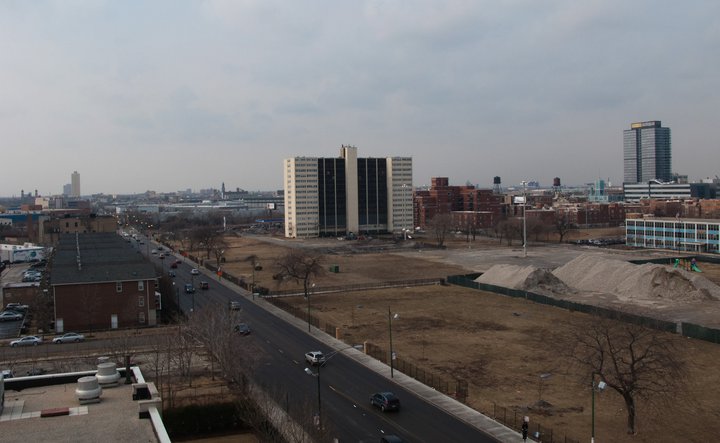
One morning several weeks ago, I spoke with Jan Tichy, one of three artists shortlisted for the Nathan Gottesdiener Foundation Israeli Art Prize 2010. As we sat in Rothschild 12, a very cool bar in the South part of Tel Aviv, a neighborhood of contrasts, constant change, creativity, class differences and construction, Tichy spoke of the happenings in his current neighborhood in Chicago, saying that March 21, 2011 will be “a significant historical moment, the last building in the last housing project will be destroyed.”
The building Tichy referred to is 1230 N. Burling Street, near the corner of Halsted and Division, in Cabrini Green, one of the high density high rise public housing projects built in the US in the years after WWII. Plagued by the same problems of poor living conditions, poverty, neglect, organized crime and violence as other public housing developments, Cabrini Green has often been the focus of media attention, with acts of random violence, such as the shooting of seven year old Dantrell Davis, killed by a stray bullet on his way to school in 1972, or then Chicago Mayor Jane Byrne moving into the project in 1981 in an attempt to change the tide of violence and urban neglect. The mayor remained in the building for three weeks.
Much has been said and written over the years in an attempt to analyze why public housing developments such as Cabrini Green and Pruitt-Igoe in St. Louis (designed by architect Minoru Yamasaki who designed the World Trade Center) have gone so terribly wrong. Some blame modernist architecture and its underlying concepts, others note the problems set in motion by the economic and social context in which these buildings were constructed, and there have been many attempts over the years to improve the situation. Ultimately, one by one, the high rises of Cabrini Green have come down, and 1230 N. Burling Street, is the last to go.
Almost everyone has had their say about Cabrini Green, but Project Cabrini Green gives the kids of the neighborhood a chance to voice their thoughts and feelings in a public space.
Tichy has been working with the kids in the Cabrini Green neighborhood, on Project Cabrini Green, an art installation that will take place in the building as it is destroyed. When I asked Tichy how he became involved in the project, he responded, “I just walked over.” Tichy, who teaches at the School of the Art Institute of Chicago, lives nearby, and initiated the project with his partner, Efrat Appel a social worker and editor. They connected with organizations already working in the neighborhood, such as, After School Matters, Cabrini Connections, Tutor/Mentor Connection, and the Marwen Foundation.
Tichy explained the project, “They will not explode the building, but use an iron wreckage ball. It takes a month; it doesn’t just happen in an instant. A moment before it begins, when the building is empty – there are 134 apartments – and we will put in each one a box with LED flickering lights. It will be self-sufficient and flicker during the night and will be destroyed together with the building.”
Tichy and Appel have been conducting weekend workshops with the kids, talking about the meaning of public art, playing games with light and art, but mostly a writing workshop on themes of house, home, neighborhood, and community. As part of the workshops the students wrote and performed their own poetry, as spoken word performance or Poetry Slams, a form born in Chicago. The installation will also incorporate poems written and recorded by the kids. A computer software program was designed for the project that will connect to the LEDs, translating the cadence of speech into the rhythm of the flickering lights. Students record their poems and the recording will go into the LED box. The boxes themselves will be built by the kids, and they are also planning a performance to mark the end of the workshop. Some of the kids participating in the workshop lived in Cabrini Green, while others come from other public housing developments.
There are many partners to the project, from the Richard Gray Gallery which has sponsored Project Cabrini Green, to the SAIC, with many students involved in several aspects from creating the website, to design the sound program and a book where the poems will be published. Another partner is the MCA (Museum of Contemporary Art) which will have a direct broadcast of the building, 24/7, during the course of the demolition. The poems can be heard on the website, “you can click on an apartment,” said Tichy, “and hear the poem with the LED lights.” They will also develop a travelling exhibit on the project which will be displayed next fall at the National Public Housing Museum. In the meantime; you can follow the project on the Project Cabrini Green website and facebook page, and Dan Gunn has an excellent interview with Jan Tichy on Bad At Sports, where you can read some of the poems written by students in the workshops.
If you are in the Chicago area, Jan Tichy will be speaking about the project today at the Art Institute.
Jan Tichy’s Installation no. 13 is currently on exhibit at the Tel Aviv Museum of Art, 27 Shaul Hamelech Blvd, Tel Aviv. The exhibit has no closing date.






Hi Doreen from Cabrini Green! I guess you were destined to be a poet…Thank you so much for writing!! Each person’s experience is different and an article can never fully express the many individual stories, your words bring us a little closer to the real Cabrini Green.
DOREEN FROM CABRINI GREEN
First and foremost I’d like to say that I am a poet
Therefore I think in rhymes not in riddles,
I will say again for all that are listening that I am a poet
I see the glass as being half filled to the middle.
At a very young age I was taught to be thankful for a little,
Because like Forrest Gump said ‘life is like a box of chocolates’,
But I prefer to say that life is like a pack of Skittles…
To all that are still reading this and for what it’s worth,
I will give you the circumstances surrounding my birth,
There was no silver spoon no baby shower nor mirth.
Looking back Mama must have had an epiphany,
Because she didn’t name me Tanya or Tiffany.
She named me plain ole Doreen from Cabrini Green.
I was brought home to join 2 brothers and a sister,
Growing up we had so much fun we played Monopoly and Twister…
For so many years I slept and awoke,
in a 3-bedroom apartment at 365 West Oak.
I can’t remember an empty refrigerator or any empty feelings
Both of our parents were always eager and willing
Ma worked for the Board of Ed and Dad worked for Oscar Mayer
So when times really got lean there was always food on the fryer.
I can’t go with popular opinion about Cabrini and say that it was
all that shoot ’em up bang bang garbage,
But I will say that for some education and upward mobility was the language.
Throughout my childhood Ma always used the phrase ‘the world doesn’t
owe you anything’,
That stuck with me and I’ve passed it down to my own kids
like a promise ring…
Great article…great project. I am a former resident of Cabrini and I am so glad that people have taken so much interest in Cabrini. I think that when all people begin to understand that it was someone’s home that the concept of public housing is understood. Everyone can’t be born rich and everyone won’t be born poor but everyone has to live somewhere. I see the demolition of Cabrini as just another tranisition in Chicago’s history because before it was Cabrini Green it was little Sicily and a few other things. Thanks for continuing to shine a light on what’s left on Cabrini.
Comments are closed.